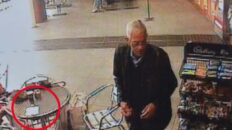Scattered around the sites of ancient Mesopotamia are thousands of devices called cylinder seals. They are equal parts stamp, credit card, and jewelry. They were how people signed for things and proved who they were in the days before paper. It’s a fascinating relic of a time long past and proof that the same issues of authentication that blockchain was developed to solve have been a part of humanity from day one.
TRANSCRIPT:
Take a look at this, I want to show you something.
I just got this in the mail and I’m really excited about it. (show it off) Have you ever seen one of these? Any idea what it is? You can see it’s round, it’s got a hole in the middle, there’s these funky characters and designs etched into it…
Most people today have never seen one of these, much less know what they were used for but back in the Bronze age these were everywhere. Thousands of these have been found in archeological sites around ancient Mesopotamia. This isn’t a real one, this is a replica, I’m not that much of a big shot.
They’re called cylinder seals. Cylinder because, well, it’s a cylinder, and seals because this design here was a signature. People used this to sign off on transactions, military orders, official statements, this is how people identified who they were, what family they belonged to.
This was equal parts ID, stamp, signature, and jewelry.
Because in the earliest days of civilization, long before paper or papyrus scrolls, records were kept with clay tablets, information punched into it in cuneiform. And they would sign those records with this, by rolling it across the clay and leaving an imprint of their seal.
Today we have digital encryption and two factor authentication – back then they had this. It’s a fascinating bit of history, and I’ve got one, I’ve also got (pull it out) some clay. So today I’m gonna try this out and talk about the history of cylinder seals and the various ways we’ve proven our identities throughout human history.
Issues of personal identity and authentication are kind-of a hot topic right now what with us all being online, data breaches, scanners, spammers, and all those lovely people that make living in the 2020s just… great.
But this is not just a modern problem, issues of identity theft, intellectual property theft, these go all the way back.
Federal Authenticity
Take this logo for example. If you see this logo, that means it’s an official document from the United States Government Publishing Office, or the GPO.
Way back then, 250 years ago, it was important to be able to prove that a document was actually from the GPO. And the Seal was the best way to do that. So they still do it to this day.
Of course it’s evolved since then, if you open a PDF from them electronically, Adobe Reader will show a blue ribbon on a signed, certified PDF. There are also non-Adobe tools, obviously.
Clearly, authenticity is important to the government. I mean how else would they ensure that the public has complete and total trust in everything they say?
Web3 and Quantum Security
Authentication issues are one of the main concerns around quantum computing, because it’s thought that quantum computers would be able to crack any encryption.
This past August, Google took steps to fix that problem by releasing an open-source security key algorithm that will supposedly be safe from quantum computer hacking.
So yeah, the battle for authentication is ongoing. And will be for oh… forever.
An Old Idea
In a sense, the whole history of civilization can be seen as an authentication arms race.
Down through the years, governments and institutions have come up with all kinds of clever authentication schemes. And all along, there have been bad actors finding even more clever ways to exploit their weaknesses.
Signet Rings
Actually, a surprising number of surviving ancient texts are tax forms. I mean, taxes suck but we’ve learned a lot about ancient civilizations because of it.
Death and taxes, am I right?
But those tax forms were really important in their time, and subject to forgery. And one clever trick they employed were Signet rings.
Some ancient Egyptians used signet rings, they worked well with clay tablets, you could just imprint the seal into the clay – later they would be used with wax on documents and sometimes just stamped on ink like a rubber stamp today. So they remained useful for a long time, all the way up through the Middle Ages.
But before the rings, especially in the Ancient Sumerian and Mesopotamian cultures, you had the cylinder seals.
Cylinder seals were carved from stone, with a hollow center so a king, scribe or whatever could wear it on a necklace. Or maybe pinned to their clothing.
That was it was always on them and if they need to use them – have to sign for something – they’d just roll it on the clay.
Or they may have had a little roller pin tool they could put it in like a paint roller.
They’ve been found all over but were especially popular in ancient Mesopotamia, which is the region around the Tigris and Euphrates rivers, now mostly modern-day Iraq.
Advantages of Cylinder Seals
One advantage of cylinder seals over signet rings is just the amount of space they provide.
A signet ring can only stamp, what, a few centimeters at most? But rolling a cylinder seal gave you multiple times more space, it was a pretty cool 3D solution, instead of carrying a giant stamp around, you could just roll it out.
This makes me wonder has there always been a vanity thing around making your name the biggest on a document? The whole John Hancock thing?
By the way, more space means more room for detail, they took advantage of it, some of these things get crazy.
Here are some from the Spurlock Museum at the University of Illinois.
Examples from the Metropolitan Museum in New York show the wide variety of materials used to make cylinder seals. Limestone or even carved shell could be used, but there were even seals made from semiprecious stones (ex Carnelian). This translucent chalcedony seal with a winged horse design is one of my favorites. (chal-sed-ony)
High Skill, High Demand
It took a lot of skill to carve designs that would make impressions like this one. In addition to the artistic challenge, all the readable elements, like letters and numbers, had to be carved backwards. It would be like copying a photograph by engraving the negative.
Not to mention the seal makers would have been entrusted with people’s very identities, they had to be someone with a lot of integrity, who wouldn’t stoop to forging fake ones for money.
And yet thousands of cylinder seals have been found. Estimates say hundreds of thousands are still buried. So it wasn’t just the rich and noble class that had these, they must have been fairly ubiquitous. Clearly, ancient seal cutters were in high demand.
Seals as Status Symbols
Early examples were almost exclusively made of soft stone that were easier to carve but rougher to handle. These were widespread in the Uruk and Jemdet Nasr periods of Mesopotamian history.
Later examples, from the period starting nearly 4000 years ago, are almost exclusively made of smooth, visually appealing hard stone.
Various decorations started showing up on the seals, like ornamental caps, which indicate they had mostly become Mesopotamian bling.
There’s one archaeological site where several seals were found that were apparently never rolled. At least , none of the impressions from those seals have been found.
Seems a shame, given how sophisticated seal impressions could be. Some had designs that were unique to a family. Others showed not only who participated in a transaction but what was traded, where it came from, and how it was supposed to be used.
I guess those were for transactions that were done regularly.
I want to hear about a scientist finding one that reads, “We’ve been trying to reach you about your car’s extended warranty…”
Eventual Decline
Which is kind of funny from an authentication standpoint. It seems like a clay tablet with a unique seal impression would be harder to fake than ink on a page. And I’m sure there were arguments like that when people were switching over. A bunch of old people complaining about how things were better in the old days with clay tablets.
I mean think of how resistant some people are to new technology now, they’d been doing things this way for like 3,000 years.
Non-Mesopotamian Cylinder Seals
I mentioned briefly earlier that cylinder seals have been found all over, and it’s true, Egypt had their own tradition of cylinder seals that were different than those in Mesopotamia, of course they’re fairly close by so they think they got it from their neighbors to the north and made it their own.
Even more interesting though, cylinder seals have been found in Mesoamerica.
One is the San Andrés cylinder seal that clearly shows a bird and the Olmec name “3 Ajaw”. The Wikipedia caption for this picture says the bird is possibly “speaking” the name.
Is it just me or does 3 Ajaw sound like a Mesoamerican rapper. Maybe this was an ad for his show.
Expert opinion is that the San Andrés seal was used to mark cloth, not clay. But the Olmec and Mesopotamian artifacts are similar. I’m not saying those two civilizations had contact 2700 years ago… But I’m not NOT saying it…
The More Things Change
But really though, that may just be parallel thinking because if there is a point to this video, it’s that the issue of authentication is universal. Whether they used cylinder seals or not, they had a way of dealing with it in ancient mesoamerica.
You could say that’s what cryptocurrency is all about, or was supposed to be all about, that’s how we deal with authentication today.
Regardless of what you think of crypto as an asset, the whole technology of blockchains and distributed ledgers is clearly just the next thing in a struggle that has gone back to the beginning of recorded history.




Add comment